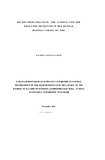| dc.description.abstract | This study was a survey whose objective was to determine the relationship between
recruitment practices, job satisfaction and employee retention in the Kenyan
manufacturing sector. The data was collected using questionnaires that had 4 sections A –
D. Section A (on biographical data) and section C ( 0n job satisfaction) was completed by
all respondents in low levels and middle levels of management. Section B (on
recruitment and selection) and section D (on job retention) was filled in by Human
Resource Managers or any senior officer in charge of HR.
The data was them analyzed using descriptive statistics that include mean, frequencies,
percentages and standard deviation. Pearson‟s Product Moment correlation was also used
to test the relationship among the key variables of study. From the study it was
established that of all the recruitment and selection methods tested all of them were being
used by all the companies, but interviews stood out as the most common used method
while medical examination was least preferred. The survey results revealed that majority
of employees were satisfied with their jobs However, the levels of satisfaction was
different amongst individuals
.
The results further showed that there was weak relationship between recruitment
practices and job satisfaction (rxy = 0.2) and recruitment practices and job retention ( rxz =
0.3) was also established that there is weak re. On the other hand this research pointed out
that there is high employee turnover within the first 2 years of employment 7.3% and
8.1% respectively. This, therefore, showed a strong positive relationship between job
satisfaction and job retention, and ( ryz = 0.7)
.
In her conclusion the researcher outlines recommendations for effective implementation
of job satisfaction indicators. The researcher also recognizes the limitations of the study
and suggests areas of further research. | en_US |

